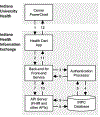Directly Integrating Health Information Exchange (HIE) Data with the Electronic Health Record Increases HIE Use by Emergency Department Clinicians
- PMID: 40496573
- PMCID: PMC12151611
- DOI: 10.1055/s-0043-1772583
Directly Integrating Health Information Exchange (HIE) Data with the Electronic Health Record Increases HIE Use by Emergency Department Clinicians
Abstract
Objectives: This article (1) develops a Fast Healthcare Interoperability Resources app, Health Dart, that integrates information from Indiana's community health information exchange (HIE), the Indiana Network for Patient Care (INPC), directly with Cerner, an electronic health record (EHR), and (2) evaluates the effect of Health Dart's implementation on HIE use.
Methods: Health Dart was implemented in 14 Indiana University Health emergency departments (EDs) using a stepped-wedge study design. We analyzed rates of INPC use in 286,175 ED encounters between October 1, 2019 and December 31, 2020. Logistic regression was used to model the probability of INPC use given the implementation context, such as user interface (UI) enhancements and the coronavirus disease 2019 pandemic.
Results: INPC use increased by 131% across all encounters (from 3.6 to 8.3%; p < 0.001) after Health Dart implementation. INPC use increased by 144% (from 3.6 to 8.8%; p < 0.001) more than 2 months postimplementation. After UI enhancements, postimplementation INPC use increased by 123% (from 3.5 to 7.8%) compared to 181% (from 3.6 to 10.1%; p < 0.001) in postimplementation encounters that occurred before UI enhancements. During the pandemic, postimplementation INPC use increased by 135% (from 3.4 to 8.0%; p < 0.001) compared to 178% (from 3.6 to 10%; p < 0.001) in postimplementation encounters that occurred before the pandemic. Statistical significance was determined using 95% confidence intervals (α = 0.05).
Conclusion: Direct integration of HIE information into an EHR substantially increased frequency of HIE use, but the effect was weakened by the UI enhancements and pandemic. HIE information integrated into EHRs in the form of problem-oriented dashboards can potentially make information retrieval more efficient and effective for clinicians.
Keywords: COVID-19 pandemic; FHIR; Fast Healthcare Interoperability Resources; electronic health record; emergency departments; health information exchange.
Conflict of interest statement
Conflict of Interest None declared.
Figures




References
-
- Bourgeois FC, Olson KL, Mandl KD. Patients treated at multiple acute health care facilities: quantifying information fragmentation. Arch Intern Med 2010;170(22):1989–1995 - PubMed
Grants and funding
LinkOut - more resources
Full Text Sources
